Python seaborn调色盘
qq_21478261 人气:01、color_palette() 函数
该函数是seaborn选取颜色关键函数
color_palette() will accept the name of any seaborn palette or matplotlib colorma
语法:seaborn.color_palette(palette=None, n_colors=None, desat=None)
import seaborn as sns import matplotlib.pyplot as plt plt.figure(dpi=250) sns.palplot(sns.color_palette())#输出默认颜色

print(sns.color_palette())#返回默认颜色元组组成的list

#palette,传入colormap名称 sns.palplot(sns.color_palette(palette='Accent'))#使用matplotlib中的colormap

#n_colors sns.palplot(sns.color_palette(n_colors=21))#返回颜色种类,超过了自动循环

# desat
sns.palplot(sns.color_palette(n_colors=21,
desat=0.2))#设置颜色饱和度
#with plt.figure(dpi=100) with sns.color_palette(n_colors=21):#循环使用色盘 _ = plt.plot(np.c_[np.zeros(21), np.arange(21)].T)
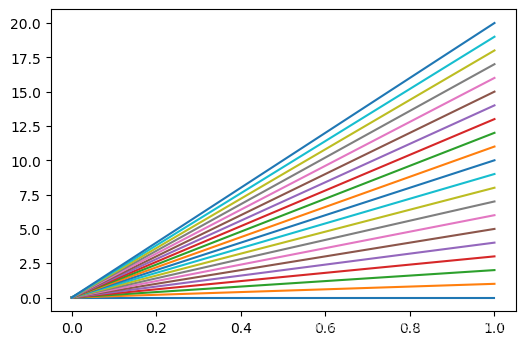
#传入hex 格式颜色号给sns.color_palette flatui = ["#9b59b6", "#3498db", "#95a5a6", "#e74c3c", "#34495e", "#2ecc71"] sns.palplot(sns.color_palette(flatui))

#颜色使用 plt.figure(dpi=100) plt.subplot(1,2,1) plt.bar([1,2,3],[1,2,3],color=sns.color_palette()[0])#取一种颜色 plt.subplot(1,2,2) plt.bar([1,2,3],[1,2,3],color=sns.color_palette()[0:3])#取三种颜色

2、 seaborn可用调色盘
分三大类:‘sequential’(渐变色), ‘diverging’(不可描述,看下图), ‘qualitative’(各种颜色区分鲜明)
choose_colorbrewer_palette函数
该函数可以预览各种颜色盘, 只能在jupyter notebook中使用。

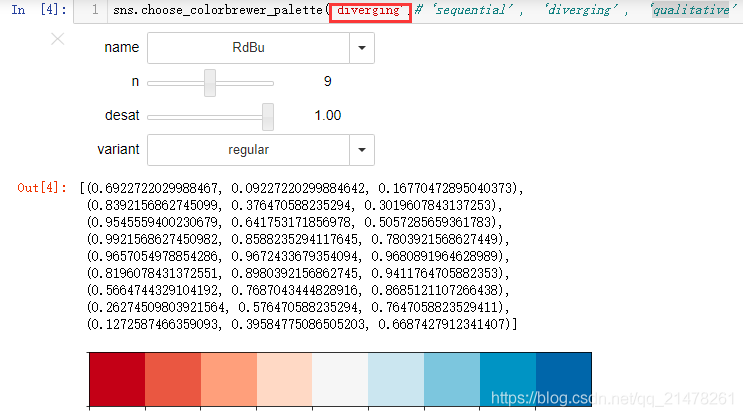
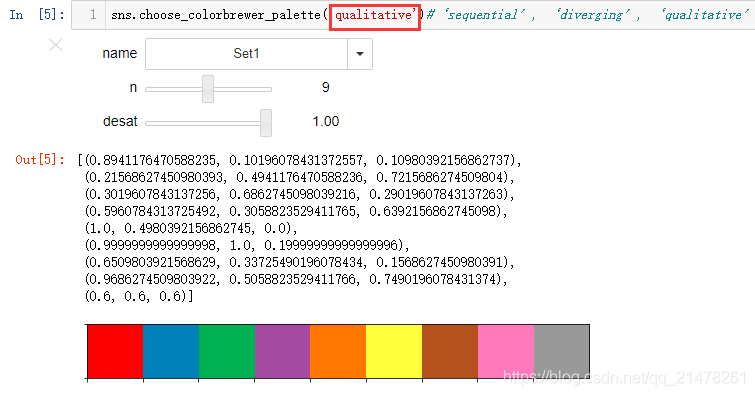
下面详细介绍上面三类颜色。
Qualitative color palettes
to distinguish discrete chunks of data that do not have an inherent ordering,分如下几类:
1、deep, muted, pastel, bright, dark, colorblind
2、hls
3、husl
4、palettable 5、xkcd
6、传入颜色list
#deep, muted, pastel, bright, dark, colorblind
for i in list('deep, muted, pastel, bright, dark, colorblind'.split(', ')):
print(i,end='\t')
sns.palplot(sns.color_palette(palette=i))
从上到下依次为:deep, muted, pastel, bright, dark, colorblind
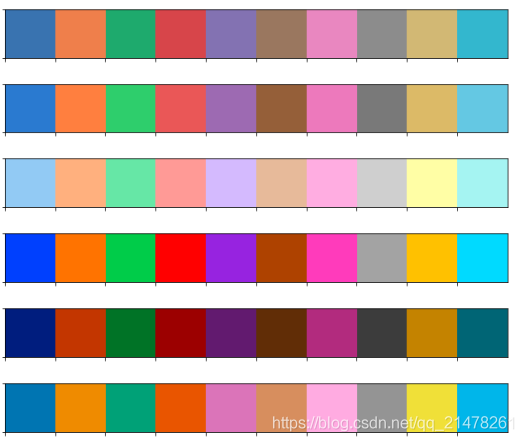
# hls sns.palplot(sns.color_palette(palette='hls')) sns.palplot(sns.hls_palette(8, l=.3, s=.8))

#husl
sns.palplot(sns.color_palette(palette='husl'))
sns.palplot(sns.color_palette("husl", 8))
import palettable#python palettable库 sns.palplot(sns.color_palette(palette=palettable.colorbrewer.qualitative.Dark2_7.mpl_colors))#使用palettable中的colormap sns.palplot(sns.color_palette(palette=palettable.scientific.sequential.Nuuk_7.mpl_colors))

#xkcd plt.plot([0, 1], [0, 1], sns.xkcd_rgb["pale red"], lw=3) plt.plot([0, 1], [0, 2], sns.xkcd_rgb["medium green"], lw=3) plt.plot([0, 1], [0, 3], sns.xkcd_rgb["denim blue"], lw=3)
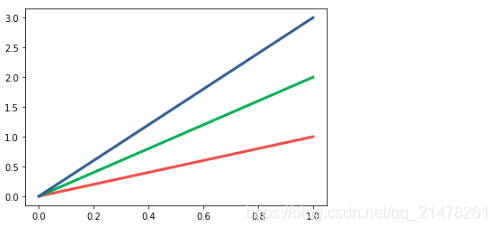
xkcd,详细可参考 :Python可视化学习之matplotlib内置单颜色
#传入颜色list给ns.xkcd_palette() colors = ["windows blue", "amber", "greyish", "faded green", "dusty purple"] sns.palplot(sns.xkcd_palette(colors))

Sequential color palettes
is appropriate when data range from relatively low or uninteresting values to relatively high or interesting values
1、"Blues"这类
2、'cubehelix',seaborn.cubehelix_palette(n_colors=6, start=0, rot=0.4, gamma=1.0, hue=0.8, light=0.85, dark=0.15, reverse=False, as_cmap=False)
3、传统色的渐变色,light_palette()、dark_palette()
#"Blues"这类渐变色
sns.palplot(sns.color_palette("Blues"))
sns.palplot(sns.color_palette("Blues_d"))#_d表示显示该颜色的深色系(“dark” palettes by appending “_d”)
sns.palplot(sns.color_palette("Blues_r"))
# cubehelix
sns.palplot(sns.color_palette("cubehelix", 8))
sns.palplot(sns.color_palette("ch:2.5,-.2,dark=.3"))#使用cubehelix接口制作颜色
sns.palplot(sns.cubehelix_palette(8, start=2, rot=0, dark=0, light=.95, reverse=True))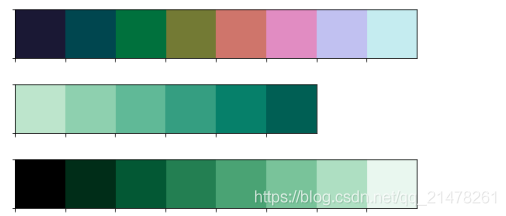
#light_palette
sns.palplot(sns.light_palette("seagreen", reverse=True))
sns.palplot(sns.light_palette((260, 75, 60), input="husl"))
Diverging color palettes
for data where both large low and high values are interesting.
1、diverging_palette()
sns.palplot(sns.color_palette("coolwarm", 7))
sns.palplot(sns.diverging_palette(240, 10, n=9))
sns.palplot(sns.diverging_palette(150, 275, s=80, l=55, n=9))
sns.palplot(sns.diverging_palette(250, 15, s=75, l=40,
n=9, center="dark"))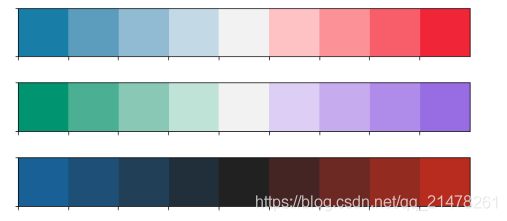
加载全部内容